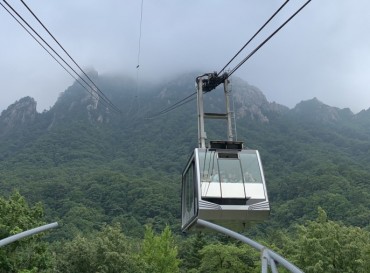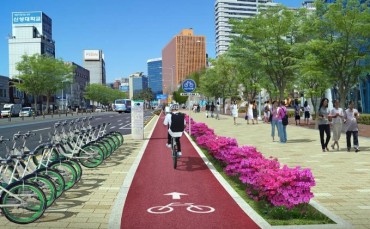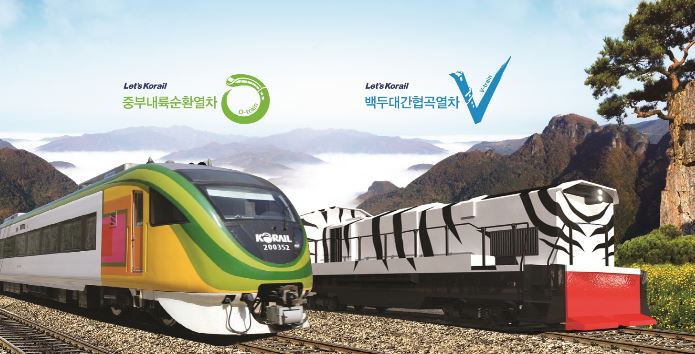
Korail’s “O-Train” and “V-Train” serving the mountainous regions of Gangwon, North Chungcheong, and North Gyeongsang provinces, which constitute parts of the Inland Mountain Belt, have attracted huge crowds since their opening in March this year. (image:KORAIL)
SEOUL, Korea, Oct 23 (Korea Bizwire) – The number of Korea’s train passengers during the first six months this year has risen 45.3 percent from the same period last year. According to the state-run Korea Railroad Corp., the number of train passengers during the first half of this year was 628,389, up from 432,575. Thanks to the rising popularity of travels on train, the number of travel agencies offering railroad trip packages has increased to 90 from last year’s 74.
The age of railway travel has come. Earlier in May, Korail announced that it would begin opening five railroad travel courses for tourists, including the Inland Mountain Belt (Jecheon-Taebaek-Yeongju), the Southern Coastal Line (Busan-Yeosu Expo), the Peace DMZ Belt (Torasan-Euijeongbu-Baekma Heights), the West Coast Gold Belt (Cheonan-Iksan), and Southeastern Blue Belt (Busan-Pohang).
The areas now open for exploration boast plenty of attractions to visits but have been underutilized because of the lack of accessibility. This is considered a model case by the state-run enterprise to revitalize local economies through tourism development.
For example, Korail’s “O-Train” and “V-Train” serving the mountainous regions of Gangwon, North Chungcheong, and North Gyeongsang provinces, which constitute parts of the Inland Mountain Belt, have attracted huge crowds since their opening in March this year. In late July, the two lines have logged in 119,412 passengers for the first 100 days since launch.
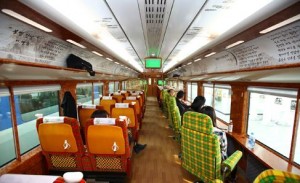
At this rate, Korail estimated, it is projected to surpass 370,000 in passenger numbers by the year’s end. (image:Korea Tourism Organization)
The daily average passengers are about 1,000 during weekdays and 2,000 in weekends. Weekend travelers must make reservations more than one month ahead of the schedule. At this rate, Korail estimated, it is projected to surpass 370,000 in passenger numbers by the year’s end.
Departing at Seoul Station, four-times-a-day O-Train stops at far-off towns like Jecheon, Taebaek, Yeongwol, and Yeongju. O-Train cars have sections for couples, families, children’s playroom, and cafés, as well as window-facing seats.
V-Train, the railway course going through Baekdu Mountain Range valleys, moves back and forth between the small towns of Buncheon, Yangwon, Seungbu, and Cheolam three times a day. The trains’ electric systems are powered by solar panels installed on the roofs. Passengers can feel nostalgic with the early 20th-century folding-door design, briquette heaters, and ceiling fans. All the train cars on V-Train line have full glass windows so that passengers could gaze outside easily. They can also breathe the fresh mountain air with the old-style window open.
The trains have contributed in no small measure to the local economy by bringing in tourists. Of the 120,000 O-Train and V-Train passengers for the past several months, about 26,000 visited North Chungcheong Province, creating economic effect worth 1.3 billion won.
For example, Buncheon Station on the V-Train line, formerly a small train stop with only 20 or so passengers stopping by a day, saw the average daily number of passengers getting off at the station rise to 393. The area surrounding the station has become a busy place for commerce with food vendors and souvenir sellers competing for tourist wallets. The same happened with the train station in Cheolam, the former coal mine with a few residents, which enjoyed a big increase in daily average visitor numbers to 358 from 15.
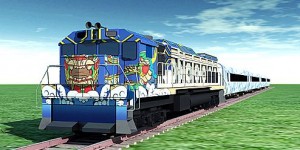
Seeing that new railroad travel courses can stimulate local economic development, the Small and Medium Business Administration has introduced a new program “Nationwide Market Tourism Train” that goes to traditional markets scattered around the country. (image:KORAIL)
Another new service called S-Train serving southern cities along the coast is also popular among train travel buffs. Visiting culture-rich locales such as Jinju, Hadong, Suncheon, and Beolgyo, the train allows passengers to get off any station they want and spend time sampling local food and visiting attractions.
Seeing that new railroad travel courses can stimulate local economic development, the Small and Medium Business Administration has introduced a new program “Nationwide Market Tourism Train” that goes to traditional markets scattered around the country. Launched on September 7, the train will visit a total of 24 markets in Danyang, Andong, Sacheon, Jeongseon, Yangpyeong, Nonsan, Namwon, Naju, and so on for three months. Korail figures it will be able to attract more than 10,000 passengers in three months until November.

If you are one of those moody travelers who want to get away to faraway quiet places in late autumn, you can choose to take the KTX train to Mt. Jiri. (image: KORAIL)
If you are one of those moody travelers who want to get away to faraway quiet places in late autumn, you can choose to take the KTX train to Mt. Jiri. Passengers can take the bullet train at Yongsan Station in Seoul and transfer to bus at Guryegu Station. As the bus goes as high as up to Seongsam Jae at an elevation of 1,100 meters, anyone can hike up the mountain easily. For those walking down to Seongsam Jae, Hwaeom Temple, and Pia Gol (Yeongok Temple), Guryegu Station-bound buses will wait to pick them up. The package tour passengers can also enjoy spas on the way and local delicacies such as freshwater sweetfish sashimi and hot crab stew.
Lifestyle (Follow us @Lifestylenews_Korea)




